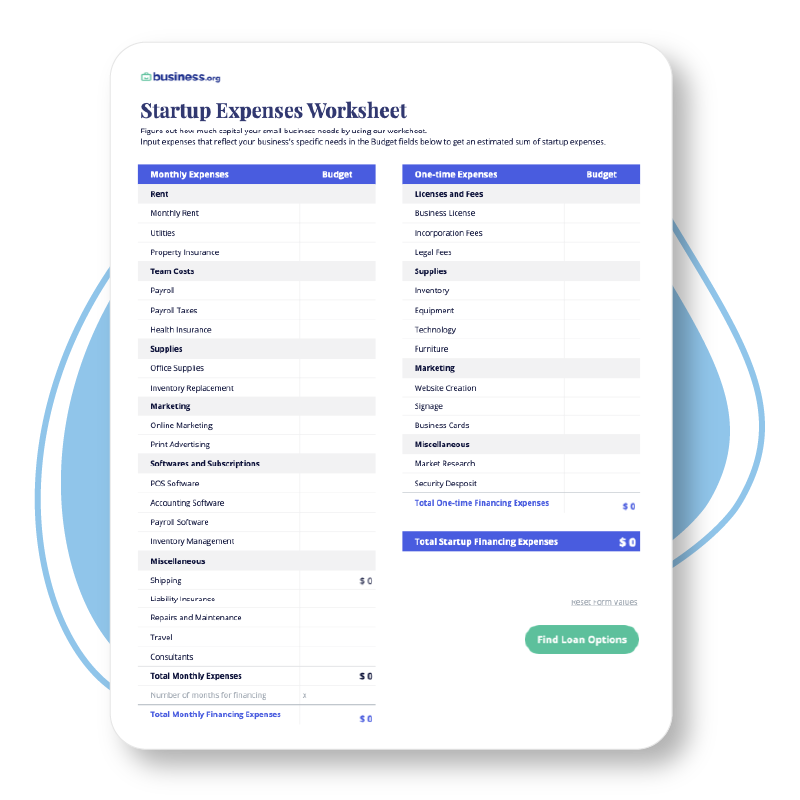We are committed to sharing unbiased reviews. Some of the links on our site are from our partners who compensate us. Read our editorial guidelines and advertising disclosure.
Types of Startup Business Loans
While running your own business is hardly ever smooth sailing, the first year can be especially tough to navigate on your own. You don’t need to let the waves of capital flowing in and out of your business sink your startup. Business loans can help your new business through rough patches or even help you start your journey.
There are several kinds of business financing available and a seemingly endless sea of lenders. Which types of loans—and which lenders—make the most sense for a startup? We’ll go over several of the options out there, explain how those loans work, and clarify when each type of loan makes sense for your small business
Types of startup business loans
- : Get a large lump sum of money and pay it back over many years.
- : Borrow money as you need it, up to a limit.
- : After you’re rejected for a loan, get a little help through government backing.
- : Get matched with investing peers for a loan.
- : Borrow money for electronics or machinery your business needs.
- : Sell unresolved invoices for up-front cash.
- : Borrow money and pay it back with frequent, profit-based payments.
By signing up I agree to the Terms of Use and Privacy Policy.
Term loans
A term loan gives business owners a lump sum of money to work with right away. To repay the loan, you need to make small, regular payments over a lengthy term set by the lender. The lender also charges interest on the total loan amount, which is paid for throughout the term.
What are they good for?
Businesses generally use term loans to cover large purchases that would be difficult or impossible to pay for right away. Those purchases should provide value over time, however, which makes the series of smaller fixed payments worth it. Loans help your business grow, but they also require you to plan your finances around monthly payments, interest, and other fees.
Where do I get one?
Financial Institutions are often the first place a business owner turns to for a term loan. However, qualifying for a loan from a local bank can be tough for new businesses. Bank loans usually provide long-term financing, with terms often between 10 to 25 years, and have a low interest rate.
In addition to brick-and-mortar banks, many online lenders also provide term loans. With them, you should expect higher interest rates—sometimes much higher—but you can usually qualify for an online term loan more quickly and more easily than a traditional bank loan.
Lines of credit
A line of credit (LOC) is another popular option for any business owner, and it works a bit differently from a term loan. Instead of receiving money up front, an LOC lets you borrow money as you need it, up to a specified limit. Then you repay whatever amount you borrow over time.
Now that you know what a line of credit is, you might be asking, Isn’t that just a credit card? And an LOC indeed functions much like a credit card.
But a couple differences separate these two credit options. First, a line of credit can allow your business to pay for some things a credit card can’t, such as payroll. Second, an LOC doesn’t usually offer spending rewards like business credit cards do.
Because many lenders offer credit cards for business accounts, small businesses might choose business credit cards, an LOC, or both.
What are they good for?
Lines of credit provide a lot of flexibility for any business. Because you only need to borrow what you need week to week, you don’t need to have a specific purchase in mind like you would for a term loan. For this reason, many businesses use their line of credit (LOC) to simply smooth out cash flow when unexpected costs or dips in income crop up.
Where do I get one?
There are actually several different types of SBA loans, and you’ll need to go through a lender and not the SBA directly to secure one. Here’s a quick list of the different loans available.
- 7(a) loan – For capital, purchases, and refinancing previous debt
- Export-assistance loan – For exporters, who are usually deemed too risky for banks
- CDC/SBA 504 loan – For businesses building up commercial real estate
- Disaster loan – For businesses recovering in a declared disaster area
- Microloans – For smaller loan amounts from lenders who identify as nonprofit organizations
You’ll need a business plan and your financial records ready when you meet with a lender, which will likely require other documents and information as part of the application process.
Peer-to-peer lending
Peer-to-peer, or P2P, lending refers to who’s doing the financing instead of how the financing takes place. These online platforms match investors with borrowers looking for a loan program.
What is it good for?
You can get relatively low rates through peer-to-peer lending, especially with a great credit score. The application process is also usually quick and painless, which means faster access to funds.
While peer-to-peer loans used to be limited to personal loans, some sites now offer business loans as well.
Where do I get it?
Some alternative lenders like Funding Circle and LendingClub use a peer-to-peer model for financing. With fewer regulations to protect consumers, read each lender’s fees and payment plans carefully.
Equipment financing
While some companies choose to lease expensive equipment for their business, equipment loans are another option. An equipment loan can cover anything from electronics to machinery or even vehicles. And you own the equipment once it’s paid for.
What is it good for?
Equipment financing is a more secure loan for the lender because the equipment itself works as collateral if a business can’t repay the loan. Payment is usually term-based, and rates are often competitive but depend on the cost and state of the equipment.
Where do I get it?
Large banks and local credit unions usually offer equipment loans. You can also check online lenders to find financing options that are faster and more accessible but often carry higher interest rates.
Make sure to get a vendor quote on the cost of your equipment before you start applying.
Invoice factoring
Invoice factoring is a way to finance business expenses, but it’s actually not a loan. Instead, business owners sell an unusual item to get cash right away: unpaid invoices.
What is it good for?
If your business needs cash fast to pay employees or cover other expenses, you might not be able to wait for all your unpaid invoices. Instead you can sell those invoices to a factoring company, who will eventually make that money back when the businesses from those invoices pay the amount owed.
Where do I get it?
Not all online lenders offer invoice factoring, but many do. Some are factoring specialists, while others offer it in addition to more traditional lending services.
Keep in mind that you’ll need to pay a factoring fee for the trouble and that a percentage of your funding will be withheld until the factoring company collects on the invoices.
Merchant cash advances
Originally made for businesses that relied on credit card sales, merchant cash advances (MCAs) have since been opened up to all sorts of businesses. Merchant cash advances provide up-front cash for a cut from your business’s future profits. Sometimes fixed payments are set up through a bank account, and other times a percentage of your credit card sales are automatically given to the lender.
What are they good for?
Merchant cash advances are usually quick to set up and don’t rely on a business or personal credit score. But they can also end up heavily costing the borrower, so small businesses should be wary when signing up.
The short length of the loan benefits businesses who want to pay off a debt faster, but it also means that the frequent payments are relatively costly.
Where do I get one?
Many online companies offer either merchant cash advances or similar short-term loans. Check the MCA repayment term and fees closely to make sure your business can afford the high-frequency payments.
Finding your best option
Finding the best funding options for a startup comes down to careful planning. You need to know exactly how much your business needs and what repayment terms you can afford. After you make plans, it’s all about finding the best rate that fits your needs as well as your qualifications.
That last part, qualifications, can be tricky to navigate for startups. In general, if your business can afford the extra time, you should pursue an option with the lowest interest rate—even if it requires a bit more paperwork. And if you get turned down, that simply means you might qualify for a competitive SBA loan instead.
Overall, term loans work perfectly when you need a lot of money up front, while lines of credit make a better fit if your business will need to pull out cash periodically. But don’t forget to look into more specific options like equipment loans if they match a looming purchase or expense for your business.
Still need help charting a course for your startup’s funding? Check out our article on how to fund your new business for additional options besides loans.
Disclaimer
At Business.org, our research is meant to offer general product and service recommendations. We don't guarantee that our suggestions will work best for each individual or business, so consider your unique needs when choosing products and services.
Source
- United States Small Business Administration, “Small Business Facts.” May 1, 2018. Accessed June 29, 2022.





